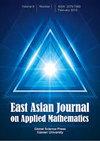Multi-Breather, Rogue Wave and Multi-Bright-Dark Soliton Interaction of the (2+1)-Dimensional Nonlocal Fokas System
IF 1.1
4区 数学
Q2 MATHEMATICS, APPLIED
引用次数: 0
Abstract
We study the (2+1)-dimensional nonlocal Fokas system by using the Hirota’s bilinear method. Firstly, a general tau-function of Kadomtsev-Petviashvili (KP) hierarchy satisfied with the bilinear equation under nonzero boundary condition is derived by considering differential relations and a variable transformation. Secondly, two Gramtype solutions are utilized to the construction of multi-breather, high-order rogue wave, and multi-bright-dark soliton solutions. Then the corresponding parameter restrictions of these solutions are given to satisfy with the complex conjugation symmetry. Furthermore, we find that if the parameter $p_{iI}$ takes different values, the rogue wave solution can be classified as three types of states, such as dark-dark, four-peak and bright-bright high-order rogue wave. If the parameter $c_i$ takes different values, the soliton solution can be classified as three type of states, including the multi-dark, multi-bright-dark and multi-bright solitons. By considering third-type of reduced tau-function to the Hirota’s bilinear equations, we give the collisions between the high-order rogue wave and the multi-bright-dark solitons on constant ($N$ is positive even) or periodic background ($N$ is positive odd). In order to understand the dynamics behaviors of the obtained solutions better, the various rich patterns are theoretically and graphically analyzed in detail.(2+1)-Dimensional Nonlocal Fokas System 的多呼吸器、流波和多亮暗孤子相互作用
我们用 Hirota 的线性方法研究了 (2+1)-dimensional 非局部 Fokas 系统。首先,通过考虑微分关系和变量变换,推导出在非零边界条件下满足双线性方程的 Kadomtsev-Petviashvili (KP) 层次的一般 tau 函数。其次,利用两种革兰氏解构建了多呼吸器、高阶流氓波和多亮暗孤子解。然后,给出了这些解的相应参数限制,以满足复共轭对称性。此外,我们还发现如果参数$p_{iI}$取值不同,流氓波解可分为暗-暗、四峰和亮-八阶流氓波等三种状态。如果参数 $c_i$ 取值不同,则孤子解可分为三类状态,包括多暗孤子、多亮暗孤子和多亮孤子。通过考虑广田线性方程的第三类还原 tau 函数,我们给出了在恒定背景(N$为正偶数)或周期背景(N$为正奇数)上高阶流氓波与多亮暗孤子之间的碰撞。为了更好地理解所求解的动力学行为,我们对各种丰富的模式进行了详细的理论和图解分析。
本文章由计算机程序翻译,如有差异,请以英文原文为准。
求助全文
约1分钟内获得全文
求助全文
来源期刊

East Asian Journal on Applied Mathematics
MATHEMATICS, APPLIED-
CiteScore
2.60
自引率
8.30%
发文量
48
期刊介绍:
The East Asian Journal on Applied Mathematics (EAJAM) aims at promoting study and research in Applied Mathematics in East Asia. It is the editorial policy of EAJAM to accept refereed papers in all active areas of Applied Mathematics and related Mathematical Sciences. Novel applications of Mathematics in real situations are especially welcome. Substantial survey papers on topics of exceptional interest will also be published occasionally.
 求助内容:
求助内容: 应助结果提醒方式:
应助结果提醒方式:


